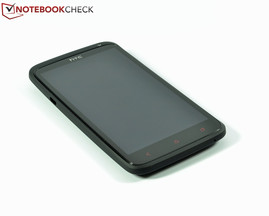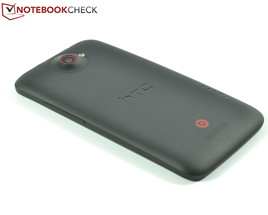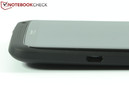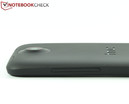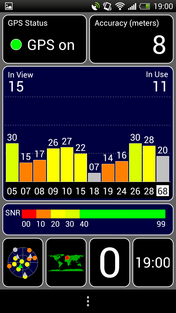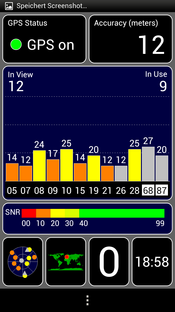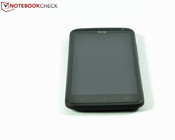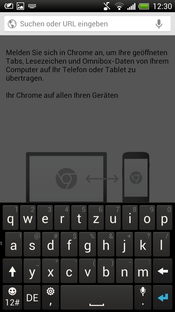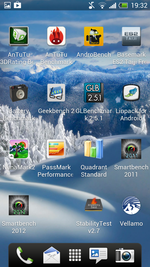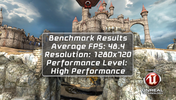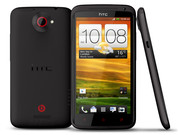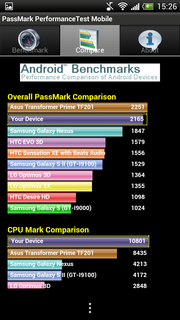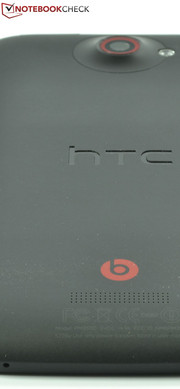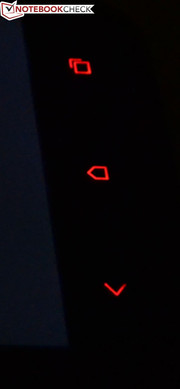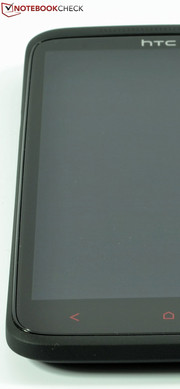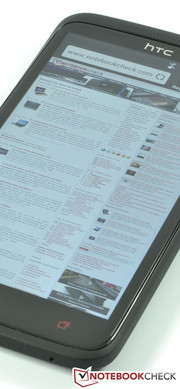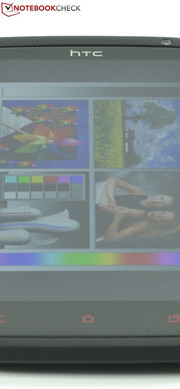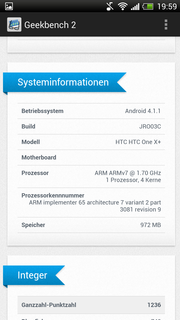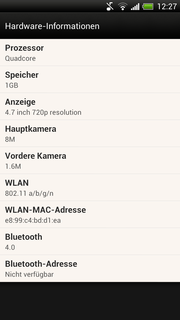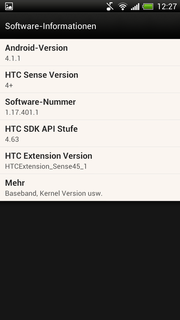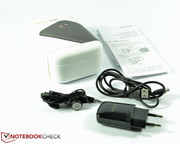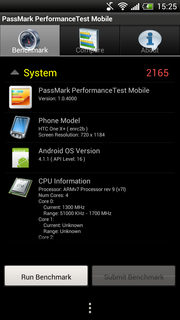Review HTC One X+ Smartphone
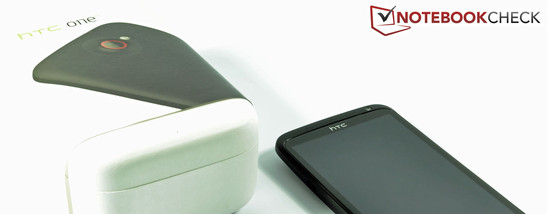
For the original German review, see here.
"What Apple can do, we've already been doing a long time." They must have been thinking that at HTC -- thus the Taiwanese engineers have reworked their Android-based top model One X and promise 27 percent greater performance. From the outside the changes are barely noticeable -- it's on the inside that HTC put their hand to the plow. If you're looking for all the good and expensive technological innards on the market, you'll find many of them in the HTC One X+. Just LTE seems to have been saved for a later update or the new Android Flagship One X5 project.
The One X+ tickles a 1.7 GHz clock frequency out of its Nvidia Tegra 3+ processor. The storage space has also grown to a full 64 GB, and the battery has expanded to a capacity of 2100 mAh. The webcam's resolution has been raised to 1.6 megapixels. Much of what you'll find in the new HTC Smartphone is already familiar from the One X: 1 GB memory, an 8 MP main camera, and an HD SuperLCD touchscreen with a resolution of 1280x720 pixels and a 4.7-inch diagonal measurement. Evolution rather than revolution seems to be the motto. Has the gentle remodeling given the new model enough umph to climb the rungs to the heights of the smartphone heavens?
Case
Here HTC held back - wisely, we think. The case of the One X was almost optimal to begin with: stable, impeccably manufactured, anti-skid coated, with Gorilla Glass to protect the panel - there's not all that much room for improvement. The changes they did make are subtle: the skeleton is a little darker than that of the predecessor model, and it has colorful highlights consisting of a red camera border, a red BeatsAudio logo and sensor keys of the same color.
Otherwise the cases of the One X+ and the One X are exactly alike, which is why we encourage you to look at our extensive review of the HTC One X for further details.
Connectivity
One of the most important upgrades from the HTC One X to our test device is the stronger Nvidia Tegra AP37 processor. The clock rate increased from 1.5 to 1.7 GHz and the working memory of 1 GB remains as it is in the SoC (System-on-a-Chip) integrated into the Nvidia GeForce graphics card.
In regards to connections and their positions, nothing has changed since the HTC One X: There's the obligatory 3.5 mm jack and a micro USB 2.0 port -- the HTC One X+ doesn't offer anything more. For more information we once again invite you to turn to our review of the HTC One X.
Software
The HTC One X+ is run on Google's current operating system, Android 4.1.1 (Jelly Bean). HTC superimposes their own optically-polished user interface, called HTC Sense UI in the current version. There's nothing groundbreaking here that the predecessor One X doesn't already offer. But there's something interesting in the possibility of using your own PC or Mac to comfortably set up the smartphone upon its first start-up via the browser-based user interface HTC Sense.com. Data backup is also possible here.
Directly compared with the iPhone 5 in browser-mode, it's clear that the smaller iPhone 5 offers a considerably stronger zoom. On the other hand, the 4.7-inch display on the HTC One X+ offers a pleasant overall view and is excellent for surfing.
Communication & GPS
The HTC One X has at its command -- like the One X -- WLAN 802.11a/b/g/n, Bluetooth 4.0 including aptX audio codec and the usual GSM and UMTS frequencies. LTE isn't supported. During testing the radio modules proved to be on the same level as those in the iPhone 5. In a big apartment with 2 walls and about 10 meters (~33 feet) between the device and the router, the transmission over WLAN was noticeably slow over both devices -- though at no point were there any interruptions in the connections. In the vicinity of the router, however, downloads went very quickly.
We also tested the reception strength of the GPS module with the "GPS test" App. The HTC One X+'s GPS module with GLONASS proved to operate quickly and accurately. The first satellites were found within seconds. Of course the device found fewer satellites inside buildings than out in the fresh air; but the respectable precision even in enclosed spaces was impressive.
HTC also treats their new Android Flagship to an NFC chip (Near Field Communication) for wireless connections with compatible terminals. Theoretically that enables the device to be used for payment functions or as a digital key substitute. However, such scenarios for possible use are not yet widely offered in Germany.
Telephone Function
The telephone app is no different from that of other Android smartphones, and thanks to the intuitive operation and clear interface there's nothing puzzling about it. Contacts already listed in the user's own Google account are automatically transferred to the phone during the first set-up.
Cameras & Multimedia
Like its predecessor, the HTC One X+ shoots photos with two camera modules. The main camera, located on the back side of the device, is the same as before and has the same resolution of 8 megapixels (a maximum of 3264x1840 pixels in 16:9 format, 3264x2448 pixels in 4:3). A BSI sensor and a 28 mm lens (aperture fixed at f2.0) work together with an LED flash. You can record videos in full HD resolution with 30 fps. While taking a video you can also shoot photos in parallel at a resolution of 6 megapixels. For an exact description of the photo and video functions we refer you again to our review of the HTC One X.
Turning our attention to the front camera: where the HTC One X only offered 1.3 megapixels, the One X+ now offers a resolution of 1.6 megapixels (1456x828 pixels at 16:9, 1456x1088 pixels at 4:3). Videos can be shot at a resolution of 1280x720 pixels. Depending on the light environment the picture quality is quite acceptable; only in poor lighting situations does a relatively high level of image noise appear. The colors are represented with a very slight red cast due to low color temperature.
Accessories
In simple and environmentally friendly packaging, as is typical for HTC, alongside the smartphone the manufacturer delivers the usual accessories. There's a compact power supply with a USB connector and a matching USB-to-MicroUSB cable. The latter doubles as a data cable to form a connection with a PC or Mac. In addition to a few short manuals, there's also a tool for opening the SIM card slide. Despite the relevant device license, the included stereo headset isn't from the accessory manufacturer BeatsAudio.
The docking station CR S650, designed for the HTC One X and available for about 60 Euros (~$81), is also compatible with the One X+. Several other accessories also remain compatible with the new device.
Warranty
The warranty from the manufacturer is good for 24 months, the accessories for 12 months. HTC doesn't offer any optional warranty extensions, but many vendors or mobile phone service providers step into the breach.
Input Devices and Operation
In terms of operation, in comparison with the HTC One X nothing has changed: The HTC One X+'s capacitive touchscreen still serves as the main input. Taps and wiping movements with fingers are quickly and precisely translated. Multi-touch gestures like, for example, pinch-to-zoom (zooming with two fingers) function just as flawlessly. For text input the HTC One X+ uses the display keyboard common to Android devices.
The touch keys beneath the display also do their job reliably. The volume control rocker on the right side of the case travels a very short distance, but you can clearly feel the click point. The power button on the top side of the smartphone, however, is a little difficult to use, due to its unclear click point.
The bottom line is that the same positive and negative points apply to the operational controls on the One X+ as applied to the One X before it. More specific information on the subject can be found in the predecessor's review.
Display
The HTC One X+ uses an SLCD2 4.7-inch display with an IPS panel with a resolution of 720p (1280x720 pixels). A plate made of Corning Gorilla Glass 2 covering the display offers strong enough protection against scratches and is very pressure-resistant. The pure numbers are exactly the same as those of its predecessor, the HTC One X. But if you compare the measured values, a difference of about 14 percent can probably be attributed to some slight variability across individual devices. The One X's test sample glowed with an average of 448.4 cd/m², whereas our test device HTC One X+ now reached an average value of 386.9 cd/m². In this category, with an average luminosity of 486.8 cd/m² and 326 PPI, the iPhone 5 did about 21 percent better. The One X+'s pixel density totaled 312.5 PPI (HTC One X: 312 PPI). The HTC One X+'s luminosity peak-value climbed to a very good 412 cd/m² (One X: 464 cd/m², iPhone 5: 499 cd/m²). With only 148.6 cd/m² (peak: 153 cd/m², 306 PPI), the Samsung Galaxy S3 can't keep up, but conversely it does possess fantastic contrast and black levels.
| |||||||||||||||||||||||||
Brightness Distribution: 91 %
Center on Battery: 392 cd/m²
Contrast: 871:1 (Black: 0.45 cd/m²)
In accordance with the brightness variability, both the black and contrast levels of the review device lie at 0.45 cd/m² and 871:1, respectively, lower than those of its predecessor and the competition (HTC One X: 0.36 cd/m², 1225:1; Samsung Galaxy S3: 0.03 cd/m², 4900:1; iPhone 5: 0.48 cd/m², 1040:1), though with these values the device is still playing in the upper league in terms of product quality. Subjectively, the brilliant colors, the high contrast and the crisp images are enough to make a user enthusiastic. In addition, the HTC One X+ contains an obligatory ambient brightness sensor that can be configured in the system settings.
The HTC One X+ scores when it comes to outdoor use. The high luminosity and good contrast generate a great picture even out in the fresh air, though due to the design of the device the display's glass surface is very reflective. A matte protective film could be a low-cost remedy here.
Performance
The new Nvidia Tegra 3+ AP37 SoC (System-on-a-Chip) built into the HTC One X+ is manufactured in a 40 nanometer structure width and clocks, in comparison to the familiar four-core Tegra 3 AP33 (for instance in the HTC One X), at a maximum of 1.7 GHz rather than 1.5 GHz (1.7 GHz single-core, quad-core: 1.5 GHz). According to HTC this should increase the performance by 27 percent. The integrated Nvidia GeForce ULP graphics card as well as the 1 GB LPDDR2 working memory with 1.066 MHz, however, are old friends from the HTC One X.
We compared the performance with several Android benchmarks in order to verify the advertised jump in performance. Firstly we took a look at browser-based benchmarks. Here the HTC One X+ was head-to-head with the competition. In the Peacekeeper test, for instance, the HTC One X+ lies on the same level as the Samsung Galaxy S3 and is beat out by the Apple iPhone 5 by a margin of 30 percent. The Sunspider 0.9.1 paints a somewhat different picture: The Galaxy S3 and the One X lie a considerable stretch behind, and the HTC One X+ dashes quite near to the quick iPhone 5 in this benchmark. In Google V8, with 2136 points our test device overtakes the HTC One X and the iPhone 5 by 30 percent, though the Samsung Galaxy S3 only lies shortly behind. But then in Browsermark 2.0 the One X+ comes in behind the iPhone 5 and the Samsung Galaxy S3 by 38 and 10 percent, respectively.
| Google V8 Ver. 7 - Google V8 Ver. 7 Score (sort by value) | |
| HTC One X+ | |
| Apple iPhone 5 | |
| Samsung Galaxy S3 | |
| HTC One X | |
| Sunspider - 0.9.1 Total Score (sort by value) | |
| HTC One X+ | |
| Apple iPhone 5 | |
| Samsung Galaxy S3 | |
| HTC One X | |
| Mozilla Kraken 1.0 - Total (sort by value) | |
| HTC One X+ | |
| Apple iPhone 5 | |
| Samsung Galaxy S3 | |
| Peacekeeper - --- (sort by value) | |
| HTC One X+ | |
| Apple iPhone 5 | |
| Samsung Galaxy S3 | |
| Browsermark - --- (sort by value) | |
| HTC One X+ | |
| Apple iPhone 5 | |
| Samsung Galaxy S3 | |
* ... smaller is better
In Linpack's multithread calculation the One X+ can claim second place behind the undefeated iPhone 5. The Smartbench 2012 benchmark is also favorable towards the test device, though the results are distinctly closer to each other. In the GPU benchmarks, directly compared with its predecessor the One X, the One X+ is the clear winner almost without exception. Only in Basemark ES 2.0 does the One X+ come in rather far behind. In comparison with the rest of the competition our picture is somewhat mixed: In the GLBenchmark 2.5 the One X+ and the Galaxy S3 are on the same display level, the iPhone 5 trumps both with a doubled frame rate of 22 FPS. In the NenaMark 2 benchmark, for example, with 58.8 FPS the Samsung Galaxy S3 does 4 percent better than the One X+. So the promised increase in performance doesn't prove to be consistent.
| AnTuTu v3 - Total Score (sort by value) | |
| HTC One X+ | |
| Samsung Galaxy S3 | |
| AnTuTu 3DRating | |
| 1024x2048 Off-screen (sort by value) | |
| HTC One X+ | |
| Samsung Galaxy S3 | |
| Apple iPhone 5 | |
| --- (sort by value) | |
| HTC One X+ | |
| Samsung Galaxy S3 | |
| Apple iPhone 5 | |
| GLBenchmark 2.5 - 1920x1080 Egypt HD Offscreen Fixed Time (sort by value) | |
| HTC One X+ | |
| Samsung Galaxy S3 | |
| Apple iPhone 5 | |
| Linpack Android / IOS - Multi Thread (sort by value) | |
| HTC One X+ | |
| Samsung Galaxy S3 | |
| Apple iPhone 5 | |
| HTC One X | |
| Smartbench 2012 - Productivity Index (sort by value) | |
| HTC One X+ | |
| Samsung Galaxy S3 | |
| HTC One X | |
| NenaMark2 - --- (sort by value) | |
| HTC One X+ | |
| Samsung Galaxy S3 | |
| HTC One X | |
| Basemark ES 2.0 - Taiji Free (sort by value) | |
| HTC One X+ | |
| Samsung Galaxy S3 | |
| HTC One X | |
To evaluate the performance of the internal memory we consult AndroBench 3. Here we see that compared with the Samsung flagship Galaxy S3, the HTC One X+ does a little better in all disciplines. Against the Google Nexus 4, however, which counts among one of the best in this test, the One X+ lies too far behind to even have its competitor in its line of vision.
| AndroBench 3-5 | |
| Random Write 4KB (sort by value) | |
| HTC One X+ | |
| Samsung Galaxy S3 | |
| Google Nexus 4 | |
| Random Read 4KB (sort by value) | |
| HTC One X+ | |
| Samsung Galaxy S3 | |
| Google Nexus 4 | |
| Sequential Write 256KB (sort by value) | |
| HTC One X+ | |
| Samsung Galaxy S3 | |
| Google Nexus 4 | |
| Sequential Read 256KB (sort by value) | |
| HTC One X+ | |
| Samsung Galaxy S3 | |
| Google Nexus 4 | |
Games
The smartphone fluidly completed the graphic demo benchmark Epic Citadel, which we just added to our test database. We will only be able to assess the relative value of the device's 48.4 FPS in high-performance mode and 46.2 FPS in high-quality mode when we have more results to compare with those numbers. Epic Citadel is based on the demanding Unreal 3 graphics engine. There is one thing we can already deduce: All currently available 3D games, especially the more demanding games from the custom-made library Tegra Zone, run smoothly and at a high level of detail on the HTC One X+ with its Nvidia GeForce ULP graphics solution. A practical example is the ego-shooter Shadowgun Deadzone (available in the Google PlayStore), which offers impressive effects and always runs fluidly. All in all, the HTC One X+ proves to have a great performance spectrum.
Sound Quality
Here our review device is no different from the previously reviewed HTC One X. For this reason we refer you to our extensive review of the predecessor for more information. On the whole the HTC One X+ performs well and reproduces very intelligible speech.
Emissions
As is true of the speech quality, the sound quality of the HTC One X+ is no different from that of the HTC One X. The speaker offers a sound that lacks bass and is dominated by treble with subdued mid-tones. But in comparison with other devices, the sound is still tolerable at maximum volume. Directly set against the iPhone 5, our review device's loudspeaker doesn't need to go into hiding.
But the 3.5 mm jack promises higher sound quality. With a capacity for high volume with little background noise and a BeatsAudio equalizer, the jack can win you over. Of course some respectable headphones or a good headset is a prerequisite. HTC should have stuck with the BeatsAudio-licensed headset from their HTC Sensation XL, since the stereo headset that comes with the One X+ has a disappointingly thin sound and is therefore only suited for phone calls.
Temperature
The surface temperatures of the HTC One X+ are nearly identical to those of the predecessor One X. At idle and when running easy applications the surfaces warm to an average of 29 °C (84 °F). The highest measurement taken was 31 °C (88 °F) on the top surface. At those values the temperatures are low to the touch.
If the smartphone is under load, the Tegra 3+ processor and the other components emit considerably more heat into the case. We measured a maximum of 47 °C (116.6 °F) on the bottom surface; the display side reached a maximum of 47.2 °C (117 °F). On average the smartphone warms to around 43 °C (109 °F). Subjectively, however, these values aren't of much consequence. There is no scenario in which the surfaces heat up so much that you don't want to hold the device in your hand. Subjectively, smartphones with aluminum casing like the iPhone 5 feel much more uncomfortable under full load. Interestingly, the HTC One X heated up a little more in some areas, but on the whole remained about 2 °C (3.6 °F) cooler. This is certainly due to the One X's weaker processor and said component's lower level of heat emission.
(-) The maximum temperature on the upper side is 47.2 °C / 117 F, compared to the average of 35.2 °C / 95 F, ranging from 21.9 to 247 °C for the class Smartphone.
(-) The bottom heats up to a maximum of 47 °C / 117 F, compared to the average of 34 °C / 93 F
(+) In idle usage, the average temperature for the upper side is 29.4 °C / 85 F, compared to the device average of 32.9 °C / 91 F.
Battery Life
As in the HTC One X, in the successor One X+ a quad-core SoC from the Tegra 3 family is at work. The Tegra 3+ also has an extra power-saving core, called a Companion Core. This core works when the device is under a low level of load or in idle mode. Because its maximum clocking frequency of 500 MHz is comparably low, the core significantly reduces the smartphone's power usage. In idle state the HTC One X+ requires between 0.5 and 1.6 Watts, values similarly low as the One X.
Naturally these numbers increase under load. Under full load in the Stability Test, with maximum display brightness and active wireless modules, our Voltcraft VC 940 measuring device revealed a power requirement of only 4.4 Watts. The One X consumed a full 32 percent more, though the One X does have a brighter panel. The Samsung Galaxy S3, with its Exynos 4 quad SoC, is content with a maximum of 3.4 Watts. The undefeated power-saving master is still the iPhone 5 with a thrifty maximum power draw of 2.9 Watts.
| Off / Standby | |
| Idle | |
| Load |
|
Key:
min: | |
HTC also improved the efficiency of their new device compared to their old HTC One X. HTC promises an up to 37 percent increase in battery life, which would enable you to talk on the phone up to 4.7 hours longer. In place of the old 1800 mAh lithium-polymer battery, HTC has now introduced an equivalent with 2100 mAh.
We tested the maximum battery life at minimum brightness and activated energy-saving mode (here, according to your wishes, the HTC One X+ limits the CPU usage as well as the brightness and deactivates both vibrations and data connections). The test ended after around 20 hours. In comparison to the HTC One X that's an increase of 2.3 hours -- so only 11.5 percent more. In the more practical WLAN test, in which the luminosity is set to 55 percent and the energy-saving mode is active, web surfing is simulated using a script that automatically loads various websites. Here the test device ran for a total of 10 hours and 58 minutes, which is about 2 hours longer than the One X.
In the Stability Test, which is less relevant for normal daily use, all four cores of the Tegra 3+ SoC are used to capacity, the display brightness is set to its maximum, and the wireless modules are activated. Here the HTC One X+ lasts a respectable 2 hours and 18 minutes. In this test the HTC One X gave up after just 1 hour and 52 minutes, so about 19 percent less time. The Samsung Galaxy S3 (also with a 2100 mAh battery) and the iPhone 5 (with a 1440 mAh battery) form the competition in this arena. As to be expected, with a maximum battery life of 22 hours and 20 minutes the iPhone 5 lies a little ahead of the competition. The Galaxy S3 doesn't do quite as well as our test device, even though its battery power is equal to that of the One X+. It does overtake the One X+, however, when it comes to the minimum battery run time. In the important WLAN test the iPhone 5 remains the unchallenged winner, but the Galaxy S3 falls far behind, running 2.5 hours shorter.
In terms of the talk time in 3G mode, at 8 hours and 31 minutes the HTC One X+ offers nearly the same talk time as the iPhone 5.
Verdict
Even the HTC One X+ doesn't represent the perfect smartphone. Our extensive review shows, however, that it can certainly compete with the best cell phones currently on the market. The well-manufactured One X+ with its attractive design is complemented by its potent Tegra 3+ quad-core SoC and the resulting powerful application and graphics performance. The bright SLCD2 IPS panel with sharp imaging, crisp colors and high viewing-angle stability is also appealing. On the whole we also like the smartphone's fluid and simple operation with the current Android operating system, including the intuitive HTC Sense user interface. The mass storage is sufficiently large with 64 GB (net 55 GB), though unfortunately it can't be supplemented by a memory card. Instead HTC offers 25 GB of additional storage space in the cloud via Dropbox. The short distance radio NFC is also on board. In general the wireless modules have a respectable signal strength. Worthy of mention are also the device's low energy consumption and therefore long battery life, the low weight of 140 grams (~0.31 pounds) considering its size and the smartphone's comfortable feel. Another plus is the great camera module, which can take excellent photos and video recordings in good lighting situations.
Negatives are the tonally-weak stereo headset and the power button with a somewhat spongy feel. If you can do without LTE and a card reader, you can currently find the HTC One X+ and its whole package for a street price of around 550 Euros (~740 dollars) -- which means it doesn't have to fear many competitors. Alternatives in the flagship battle are the Samsung Galaxy S3 and the Apple iPhone 5. HTC One X owners will have to thoughtfully weigh whether the slight improvements are worth a new purchase.




